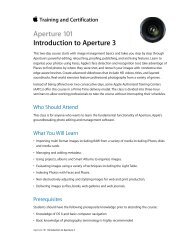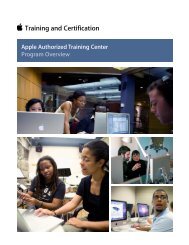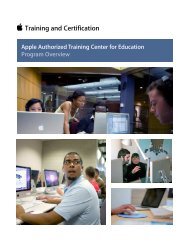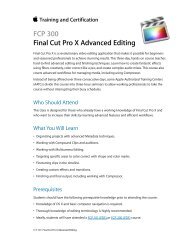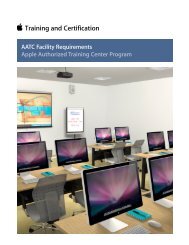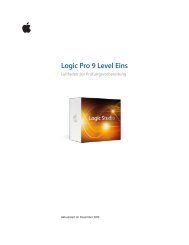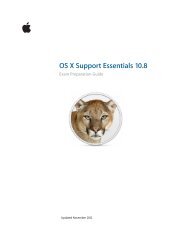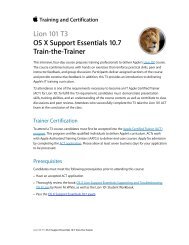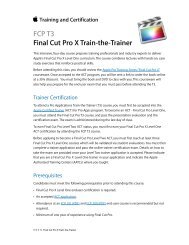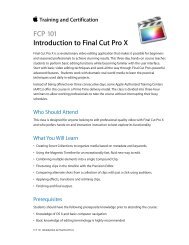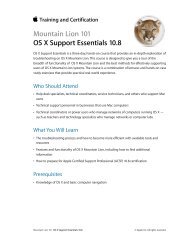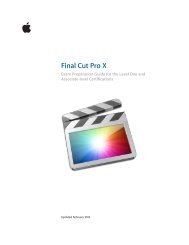Aperture 3 (PDF) - Training - Apple
Aperture 3 (PDF) - Training - Apple
Aperture 3 (PDF) - Training - Apple
Create successful ePaper yourself
Turn your PDF publications into a flip-book with our unique Google optimized e-Paper software.
<strong>Aperture</strong> 3 Exam Preparation Guide<br />
• Correct chromatic aberration<br />
• Specify and use an external editor<br />
Lesson Eight review questions<br />
After completing Lesson Eight, you should be able to answer the following<br />
questions:<br />
1. When editing with an external editor, what file does <strong>Aperture</strong><br />
send to the external application?<br />
2. What does the Add Point button do in the Curves<br />
adjustment?<br />
3. What’s the functional difference between the White Balance<br />
and Tint controls?<br />
4. Can curves be used to correct white balance issues?<br />
5. True or false: It’s impossible to adjust the hue, saturation, and<br />
luminance of a color that does not appear in the Color<br />
controls.<br />
Answers<br />
1. <strong>Aperture</strong> creates a new master file, which is sent to the<br />
external application. You can choose to create a PSD or TIFF<br />
format file in 8- or 16-bit resolution.<br />
2. The Add Point button can be used to select a point on the<br />
image, which is then mapped to the curve editor to place a<br />
curve point.<br />
3. The White Balance control makes uniform adjustments to all<br />
tonal values in an image. The Tint Controls can selectively<br />
neutralize color casts that affect only the shadows, midtones,<br />
or highlights.<br />
4. Curves can adjust both luminance and color. Because it can<br />
adjust individual RGB color channels, you could use it to<br />
correct white balance issues.<br />
5. False. You can use the Color eyedropper to identify any image<br />
hue that needs adjusting.<br />
Lesson Nine objectives<br />
Upon completion of Lesson Nine, “Making Local Adjustments with<br />
Brushes” in the <strong>Apple</strong> Pro <strong>Training</strong> Series book “<strong>Aperture</strong> 3,” you should be<br />
able to complete the following tasks. Approximately two items from this<br />
lesson are included in the pool of exam questions, drawn randomly from<br />
the following objectives:<br />
• Use Quick Brushes to correct problematic areas.<br />
• Add blur to simulate shallow depth of field.



